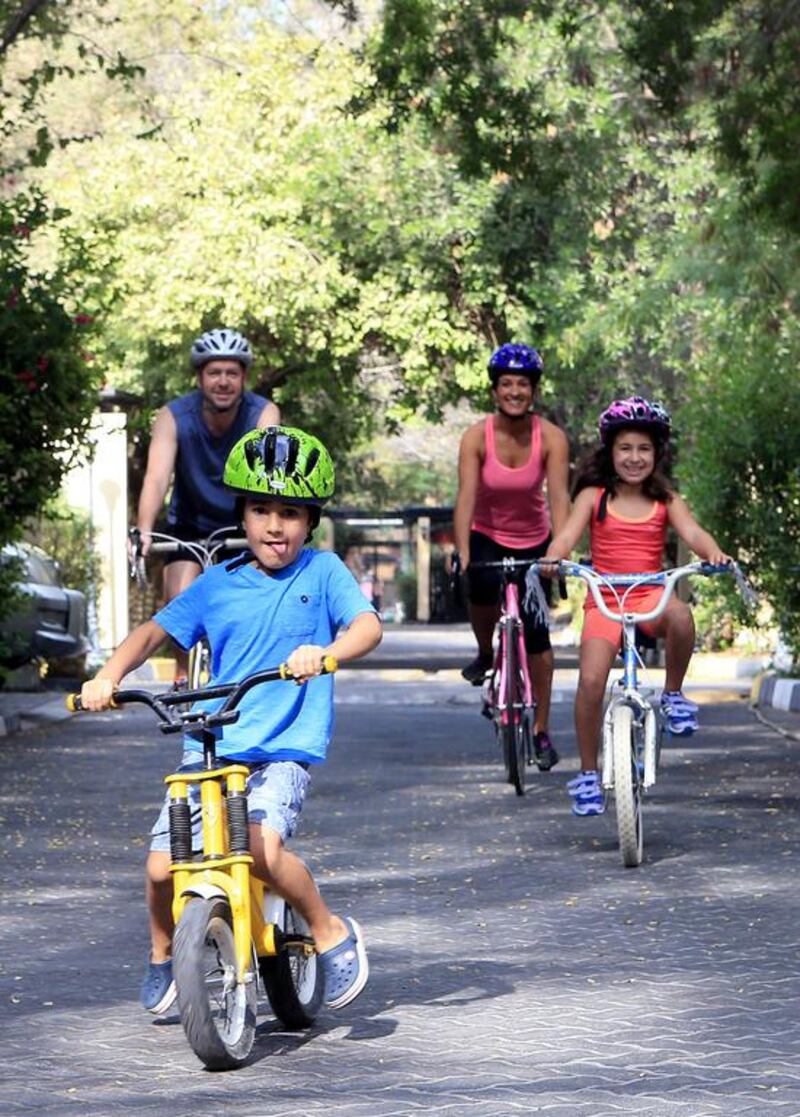It’s that time of year when we reflect on what we’d like to change about our lives and make resolutions about improving in the coming months. For mums, this is a good time to set in place a comprehensive plan of action – covering everything from eating to exercising – that will bring about positive and, hopefully, permanent lifestyle changes for the entire family.
“Family goals help you focus on your values and priorities,” says Abu Dhabi-based wellness expert and motivational speaker Jules Lewis. “Your goals can be short or long-term, fun or serious. They might include volunteering, becoming more physically active, enjoying nature more, spending more time together, or saving money for a family holiday.”
Lewis recommends a brainstorming session to jot down everyone’s ideas.
“Choose a few of the best ideas and discuss the pros and cons,” says Lewis. “When you all agree on your top family goals, describe exactly what you want to achieve and visualise your success – what you see, feel and hear when you are achieving your goal.
“Post your goals where everyone can see them, such as on the fridge or family noticeboard. Make adjustments as you go along – what’s working, what’s not working. And when it is working, be sure to celebrate.”
Parents must set a healthy example
The most common new year’s resolution people make is to get fit and lose weight. It’s also the one most commonly broken. But when tackled head-on as a family, it is more likely to end in success.
The personal trainer Jasvinder Davies, 36, exercises at least once a week with her husband Nick, 44, and children Mia, 8 and Jake, 4.
As well as strolling around their favourite Abu Dhabi haunts, the family goes cycling together every Saturday, and also dabbles in hiking, kayaking, horseriding and yoga.
“If kids see their parents exercising, it’s more likely to be a lifelong habit,” says Jasvinder. “If I’m testing out my workouts for the week, Mia will put on her trainers and join me. For her 8th birthday party last month, we threw a yoga party. Sometimes all four of us get our mats out for a group yoga session.”
Exercising together is also a way for families to interact without the distractions of computers or TV. Physical activity boosts kids’ concentration and increases serotonin function in their brains, making for happier families.
“Jake, especially, has a much better temperament when he’s been out exercising,” says Jasvinder. “Afterwards, the kids feel like they’ve achieved something. They come home starving, and sleep well because they’ve had fresh air.”
During walks, Jasvinder plays games to keep the kids’ spirits up. “On the pavement, we play a game of avoiding the cracks or stepping on the lines,” she says.
“We do a lot of counting with Jake. So I say: ‘Walk 20 steps, run 20 steps, if he wants to be carried, I say: ‘Go backwards for 10 steps, then I’ll pick you up’. But by the time he’s counted that, he’s waiting for the next instruction.”
Jasvinder’s tips for family fitness
• It’s best to let the kids lead, so find out first what they want to do.
• Show them it’s fun. What about going to the beach to look for shells? That’s exercise, though they might not realise it, and it can be fun bonding time too.
• Children will often run really fast, then stop. They don’t have the endurance to do it for long. A high rate of exertion of 20 minutes is enough.
Eating together nourishes more than the body
Sharing a nutritious family meal is good for the soul, brain and body of all family members, and the new year is an opportunity to start making it a daily ritual.
The Abu Dhabi-based nutritional scientist Nicola Pearson runs nutrition-within.com and specialises in helping families improve their diets.
“Eating together is about nourishing yourself and your family,” she says. “It’s a time to share not only nutritious food, but also family values, connect with one another, exchange ideas and develop positive eating habits.
“Children and adolescents that share positive mealtimes with their family have better psychological well-being and better school performance. They’re also less likely to be overweight, have disordered eating or be involved in high-risk behaviours.”
One Emirati family that always try to tuck in together is the Albishrs – mum Maryam, dad Omar and children Alreem, 11; Abdullah, 7; Aisha, 5; Nahyan, 3; and Fadwa, 7 months.
“I come from a family where we all ate together and when I got married, I promised myself I’d do the same,” says Maryam, 37. “I’d like my kids to continue this tradition in their future married lives.”
Omar, who works for the Abu Dhabi Tourism Authority, can’t be at every meal due to work commitments, but when he is able to join his family at mealtimes, Maryam notices how her children react.
“Once he’s in the dining room, they ask to eat what their father is eating,” she says. “They’ll sit next to him and imitate what he’s doing.”
Maryam also found her children were inspired to be more adventurous with their food by watching others.
“When I started mingling with friends from different parts of the world, I tried to involve my kids so they could see their cultures,” she says. “They saw these kids eat differently to us – things like sushi, which was so weird to me at first. It also helped me look at the world from a different perspective.
“Now, when my kids go to a German, Spanish or Portuguese party, they taste the different dishes on offer.”
Nicola’s ideas for making family mealtimes fun for everyone
• Plan a menu together. This takes a few minutes at the start of the week. Everyone is involved and it eliminates last-minute decision-making. Ask younger children to add coloured stickers to the plan for the fruits and vegetables included, to encourage eating a rainbow-a-day.
• Cook together. Children are learning about which foods nourish them, ingredients that work together, and how food feels as it’s being prepared. You’ll have a “helper”. When they’re older, they can cook, with you playing the assistant.
• At the table, turn off TV, phones and tablets. Now is the time to focus on your food and family. A 2014 study by Wansink and Kleef found that the rituals of eating as a family at the table, having meaningful conversations, and remaining at the table until everyone is finished were associated with having a lower BMI.
• Show gratitude. Stop for a moment before eating and say thank you. Where did your food come from? This pause also promotes the initial stage of digestion, stimulates saliva and gastric fluids in your stomach, aiding nutrient absorption and digestion.
• Add salads, vegetables or new foods. Have a “try bowl” in the centre of the table to introduce new foods – this is useful for fussy eaters and anyone who is still feeling hungry. Leftovers can be added to a soup or used for lunches the following day.
• Wean everyone off the expectation of a dessert. Offer fruit or natural yogurt as an alternative.
Get plenty of rest to avoid sleepwalking through life
Have you recently been caught wearing a top inside out, putting salt in your tea or forgetting why you’d just walked into a room?
If the little gremlins in the house are stealing your sleep it’s time to fight back.
The National Sleep Foundation in America advises parents of children who are night owls to enforce rules, set a good example and define boundaries around electronics use.
In its 2014 survey, the NSF found that 89 per cent of adults and 75 per cent of children had at least one electronic device in their bedrooms, and leaving them on at night was deemed particularly disruptive to sleep.
The NSF recommends kids between the ages of 6 and 10 should get 10 to 11 hours of sleep, and those between the ages of 11 to 17 need between 8.5 and 9.5 hours.
Parents with babies and young children tend to suffer the most sleep-deprivation. J, an Abu Dhabi mum of four from Ireland, has three-month-old twins, who were keeping her up 24/7. Knowing her maternity leave was coming to an end, she decided it was time for drastic action. So she hired maternity nurse, Elizabeth, then 62, to fly in from the United Kingdom and spend three weeks establishing a night-time routine.
“The twins were a nightmare in terms of sleeping and feeding. From the beginning, I fed them 12 times a day, but it multiplied by two. Between bottle-feeding and breastfeeding, it was overwhelming. The longest they’d ever slept was three hours, and not at the same time.
“Elizabeth was a real Mary Poppins. On the first night, she got them to sleep for seven hours straight. She upped the amount of feed and reduced the frequency, and took care of them during the night.”
Elizabeth told J to raise the top ends of their cots, so the twins’ digestive systems were pointing downwards. “She also encouraged us to give ‘noodie-woodie time’,” says J. “Every night, we took off their clothes in a warm room and let them play naked. It was all about tiring them out, and following a strict routine.
“I had all sorts of bottles for reflux, but she threw them all out. We spent a lot of time learning how to wind properly.
“And the last milk feed had to be finished, even if it meant taking off clothes to wake them up again.”
The strict routine meant by the time Elizabeth left, the twins were sleeping for more than 10 hours straight.
“It was still tough going back to work,” says J. “But I was actually able to enjoy them again when I came home.”
Lily Kandalaft, 31, also hired a maternity nurse to settle her son into a sleep pattern and it inspired her to set up her Dubai-based company Malaak Mama & Baby Care, the UAE’s first exclusive maternity nursing agency.
“Following a routine really convinced me of the science behind it, as well as the importance of having support in the first few months”, says Kandalaft, who is now qualified as a maternity nurse herself.
Lily’s sleep suggestions
• Make sure your baby doesn’t become overtired by structuring his social day to fit in with their sleeping and feeding habits.
• Try not to give the child foods that are high in sugar and salt, especially before bedtime.
• Teach your child to self-soothe. It’s important from the early days to get them used to having their own space to sleep, ideally in a separate room. This teaches them to be happy in their own company.
• Keep your bedtime routine calm, with dimmed lights and peaceful background music. Limit the number of visitors in the bedroom, and spend quality time reading a story before settling your child into bed.”
Immerse yourselves in the local culture
The best way to immerse yourself in another country and improve your enjoyment of the experience is to learn the local language. If you live in the UAE and you’re not a native speaker, why not take on Arabic and challenge your kids to understand what you’re trying to say to them?
Rosa Cook, 9, is learning Arabic at The British School Al Khubairat in Abu Dhabi. Last year, her Filipino mum Liza, 45, started a free beginners Arabic course that the school offers to parents.
“My primary reason was to help Rosa with her Arabic homework,” says Liza. “Learning Arabic is fun, though also very challenging. Arabic has sounds that the English language doesn’t have. So you can imagine my pronunciation needs a lot of work.
“I enjoy writing Arabic. It’s very relaxing – more drawing than writing really. I like reading Arabic signs when I’m in the car.
“Being a full-time mum, I have more time on my hands than my daughter, so my Arabic might be better than hers by now. Though she would never admit it.”
Useful Arabic phrases:
Sabah al khair: Good morning
Masa al khair: Good evening
Marhaba: Hi
Marhabtain: Denotes saying hello twice
Kef al-hal: How are you?
Ana bekhair: I’m fine
Alhamdulillah: Thank God
Tafadal ala al qaada: Join us for lunch
Tafadal ala esha: Join us for dinner
Tosbeh ala khair: Good night





